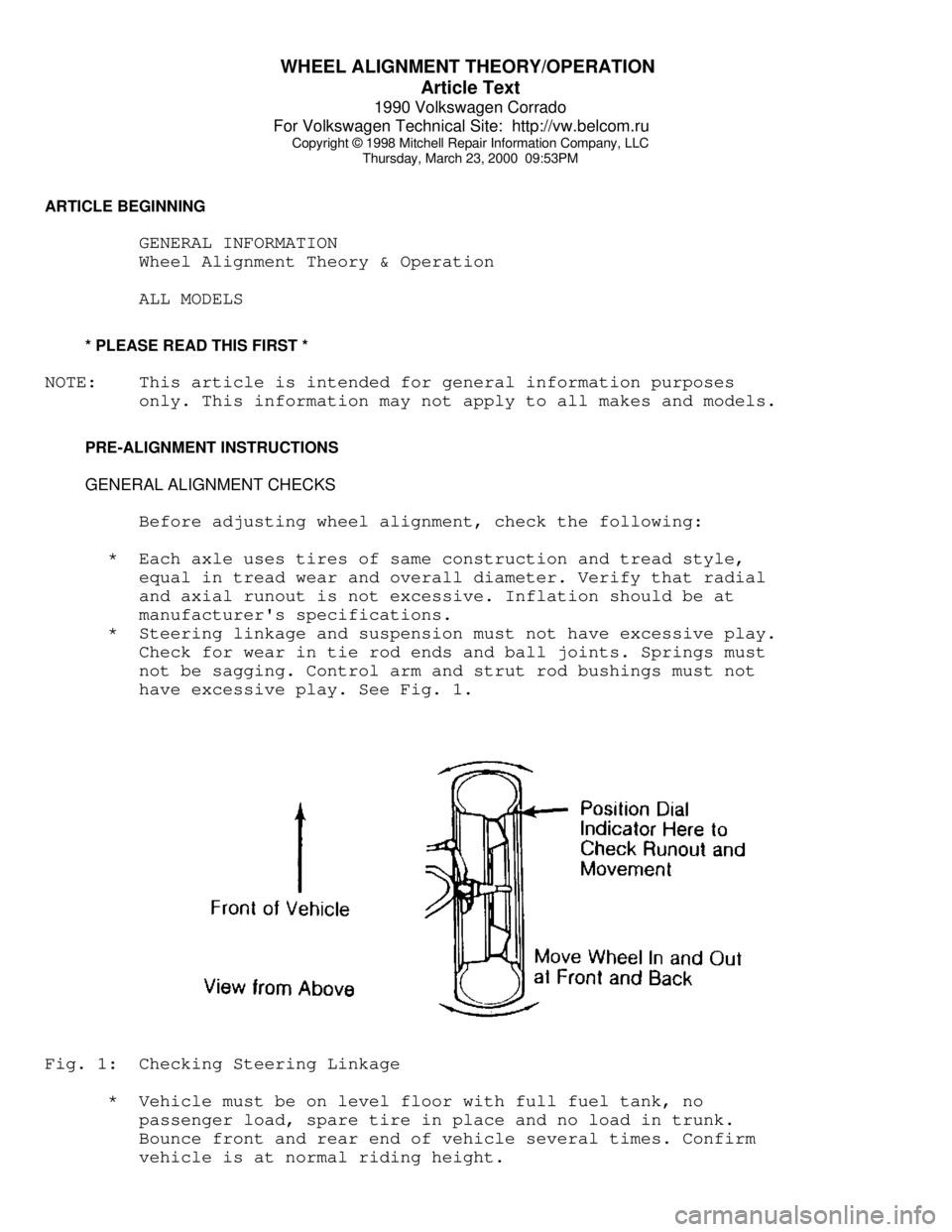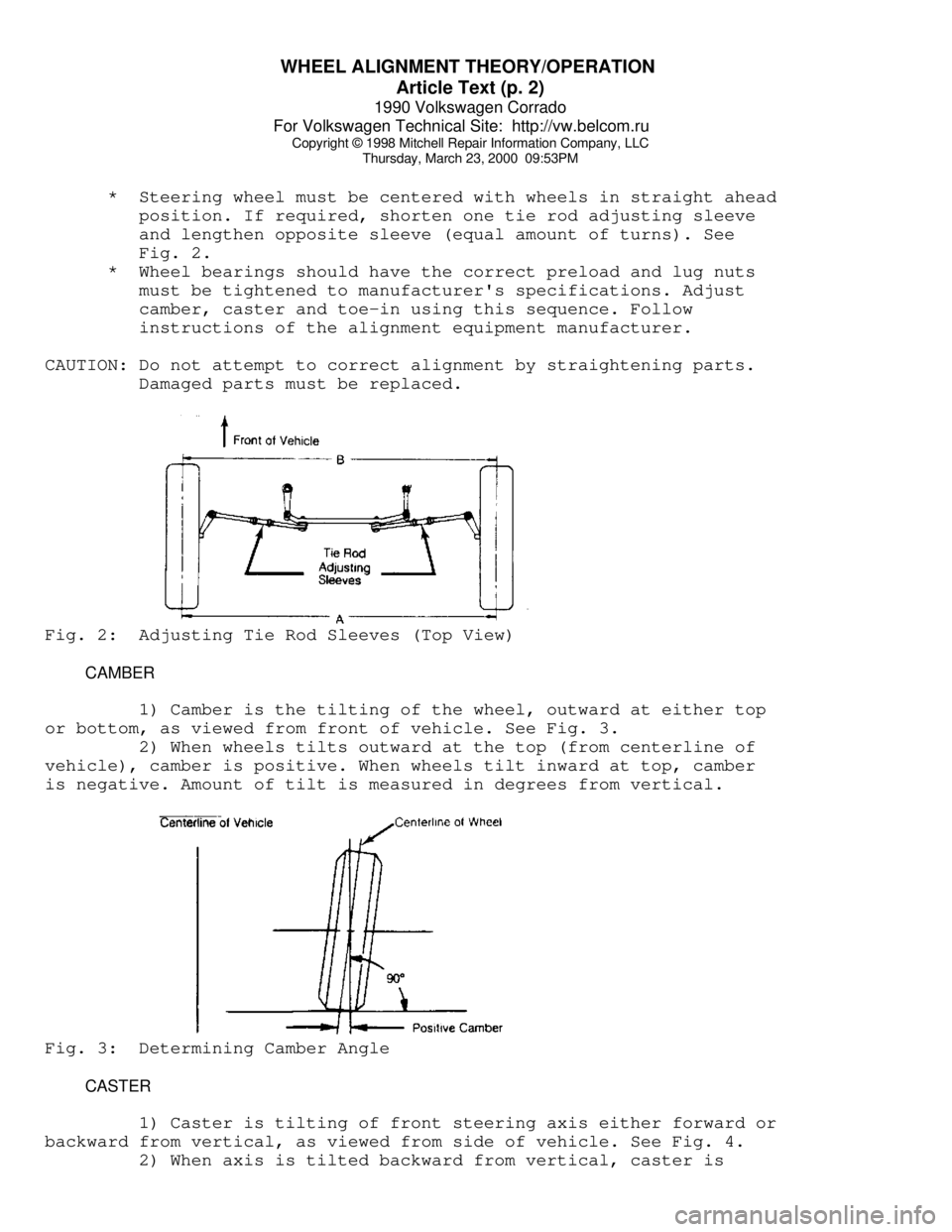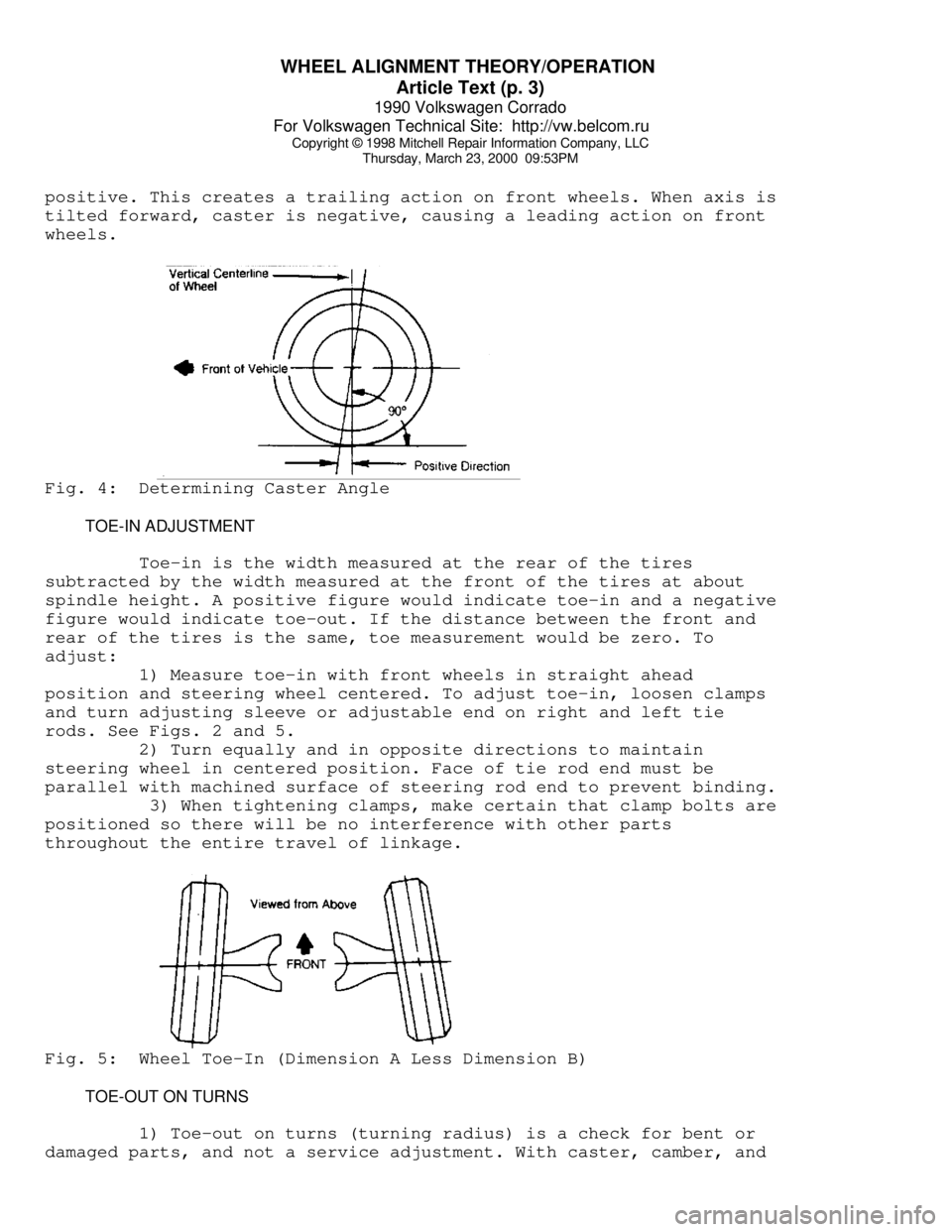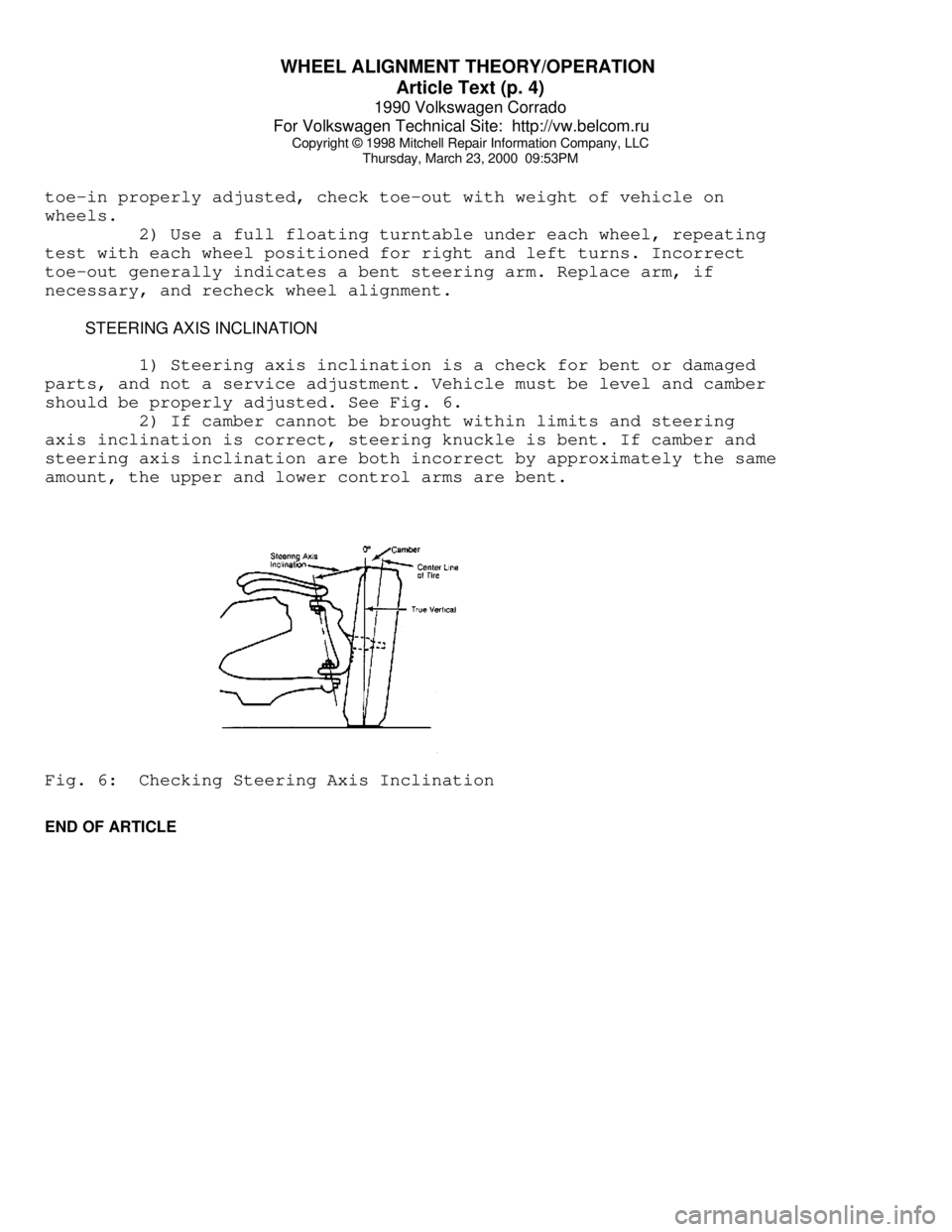1990 VOLKSWAGEN CORRADO wheel
[x] Cancel search: wheelPage 880 of 906

WHEEL ALIGNMENT SPECIFICATIONS & PROCEDURES
Article Text
1990 Volkswagen Corrado
For Volkswagen Technical Site: http://vw.belcom.ru
Copyright © 1998 Mitchell Repair Information Company, LLC
Thursday, March 23, 2000 09:53PM
ARTICLE BEGINNING
1990-91 WHEEL ALIGNMENT
Specifications & Procedures
1990-91 Passat
1991 Cabriolet, Corrado, Fox, Golf, GTI, Jetta, Vanagon
PRE-ALIGNMENT INSTRUCTIONS
NOTE: Prior to performing wheel alignment, perform preliminary
visual and mechanical inspection of wheels, tires and
suspension components. See ALIGNMENT THEORY/OPERATION in
the WHEEL ALIGNMENT Section.
RIDING HEIGHT ADJUSTMENT
NOTE: On vehicles with electronic chassis controls, all systems
should be functional before attempting riding height or
wheel alignment adjustment.
Before adjusting alignment, ensure difference in riding
height between left and right sides of vehicle is less than 1" (25.4
mm). Riding height must be checked with vehicle on level floor and
tires properly inflated. Bounce vehicle several times and allow
suspension to settle.
Visually inspect vehicle for signs of abnormal height from
front to rear or side to side. Check passenger and luggage
compartments for extra heavy items and remove if present. If
difference in riding height between left and right sides of vehicle is
NOT less than 1" (25.4 mm), check suspension components and repair or
replace as necessary.
WHEEL ALIGNMENT SPECIFICATIONS
WHEEL ALIGNMENT SPECIFICATIONS TABLEÄÄÄÄÄÄÄÄÄÄÄÄÄÄÄÄÄÄÄÄÄÄÄÄÄÄÄÄÄÄÄÄÄÄÄÄÄÄÄÄÄÄÄÄÄÄÄÄÄÄÄÄÄÄÄÄÄÄÄÄÄÄÄÄÄApplication Preferred Range
Cabriolet
Camber (1)
Front ................ 5/16 ............... -3/16 To 13/16
Rear ................ -1 1/4 .......... -1 13/16 To -11/16
Caster (1) ........... 1 3/16 ............ 1 5/16 To 2 5/16
Toe-In (2)
Front .......... -1/8 (-3) .. -3/16 To -1/16 (-4.5 To-1.5)
Rear ............ 5/32 (4) ........ 1/32 To 9/32 (1 To 7)
Toe-In (1)
Front ................ -1/4 ................. -3/8 To -1/8
Rear ................. 5/16 ................. 1/16 To 9/16
Toe-Out On Turns (1)
Page 881 of 906

WHEEL ALIGNMENT SPECIFICATIONS & PROCEDURES
Article Text (p. 2)
1990 Volkswagen Corrado
For Volkswagen Technical Site: http://vw.belcom.ru
Copyright © 1998 Mitchell Repair Information Company, LLC
Thursday, March 23, 2000 09:53PM
Inner ................. 20 ......................... .....
Outer ............... 18 1/2 ....................... .....
Corrado
Camber (1)
Front ............... -21/32 ................. -1 To -5/16
Rear ................. -1/2 ........ -1 21/32 To -1 11/32
Caster (1) ........... 1 19/32 ........... 1 3/32 To 2 3/32
Toe-In (2)
Front ................ 0 (0) . -3/32 To 3/32 (-2.5 To 6.5)
Rear .............. 5/32 (4) .... 1/16 To 1/4 (1.5 To 6.5)
Toe-In (1)
Front .................. 0 ................. -5/32 To 5/32
Rear ................. 11/32 ................. 3/16 To 1/2
Fox (Except Wagon)
Camber (1)
Front ................ -1/2 .............. -13/16 To -3/16
Rear ................ -1 1/2 .................... -2 To -1
Caster (1) .............. 2 ............. 1 11/16 To 2 5/16
Toe-In (2)
Front ............. -1/16 (-1.5) ...... -1/8 To 0 (-3 To 0)
Rear .............. 7/32 (5.5) ..... 1/8 To 9/32 (3 To 7)
Toe-In (1)
Front ................. -1/8 .................... -1/4 To 0
Rear ................. 7/16 .................. 1/4 To 9/16
Fox Wagon
Camber (1)
Front ................ -1/2 ............... -13/16 To 3/16
Rear ................ -1 1/2 ..................... -2 To 1
Caster (1) ............ 1 3/4 ............ 1 7/16 To 2 1/16
Toe-In (2)
Front ............ -1/16 (-1.5) ...... -1/8 To 0 (-3 To 0)
Rear ............ 5/32 (4) ...... 1/16 To 1/4 (1.5 To 6.5)
Toe-In (1)
Front ................ -1/8 .................... -1/4 To 0
Rear ................. 5/16 ................... 1/8 To 1/2
Golf & Jetta
(Except GLi)
Camber (1)
Front ................ -7/16 ................ -3/4 To -1/8
Rear ............... -1 11/16 ............... -2 To -1 3/8
Caster (1) ............ 1 1/2 ...................... 1 To 2
Toe-In (2)
Front ................ 0 (0) . -1/16 To 1/16 (-1.5 To 1.5)
Rear ............. 7/32 (5.5) ....... 1/8 To 5/16 (3 To 8)
Toe-In (1)
Front .................. 0 ................... -1/8 To 1/8
Rear ................. 7/16 ................... 1/4 To 5/8
GTI & Jetta GLi
Camber (1)
Front ................ -9/16 ................ -7/8 To -1/4
Rear ............... -1 11/16 ............... -2 To -1 3/8
Caster (1) ........... 1 9/16 ............ 1 1/16 To 2 1/16
Page 882 of 906

WHEEL ALIGNMENT SPECIFICATIONS & PROCEDURES
Article Text (p. 3)
1990 Volkswagen Corrado
For Volkswagen Technical Site: http://vw.belcom.ru
Copyright © 1998 Mitchell Repair Information Company, LLC
Thursday, March 23, 2000 09:53PM
Toe-In (2)
Front ................ 0 (0) . -1/16 To 1/16 (-1.5 To 1.5)
Rear ............. 7/32 (5.5) ....... 1/8 To 5/16 (3 To 8)
Toe-In (1)
Front .................. 0 ................... -1/8 To 1/8
Rear ................. 7/16 ................... 1/4 To 5/8
Passat
Camber (1)
Front .............. -1 11/32 ............. -1 11/16 To -1
Rear ............... -1 21/32 .............. -2 To -1 5/16
Caster (1) ........... 1 21/32 ........... 1 5/32 To 2 5/32
Toe-In (2)
Front ................. 0 (0) -3/32 To 3/32 (-2.5 To 2.5)
Rear ............ 7/32 (5.5) ... 3/32 To 11/32 (2.5 To 8.5)
Toe-In (1)
Front .................. 0 ................. -5/32 To 5/32
Rear ................. 13/32 ............... 5/32 To 21/32
Toe-Out On Turns (1) .... N/A ...............................
Vanagon (Except Syncro)
Camber (1)
Front .................. 0 ................... -1/2 To 1/2
Rear ................ -13/16 ............. -1 5/16 To 5/16
Caster (1) ............ 7 1/4 .................. 7 To 7 1/2
Toe-In (2)
Front .............. 5/32 (4) ...... 1/32 To 9/32 (1 To 7)
Rear ................ 0 (0) ....... -5/32 To 5/32 (-4 To 4)
Toe-In (1)
Front ................ 5/16 ................. 1/16 To 9/16
Rear ................... 0 ................. -5/16 To 5/16
Vanagon (Syncro)
Camber (1)
Front ................ 5/16 ..................... 0 To 5/8
Rear ................. -1/4 ............... -7/16 To -1/16
Caster (1) ............ 4 5/8 .............. 4 3/8 To 4 7/8
Toe-In (2)
Front ................ 0 (0) ....... -1/8 To 1/8 (-3 To 3)
Rear ........... 1/16 (1.5) ... -1/16 To 3/16 (-1.5 To 4.5)
Toe-In (1)
Front .................. 0 ................... -1/4 To 1/4
Rear .................. 1/8 .................. -1/8 To 3/8
(1) - Measurement in degrees.
(2) - Measurement in inches (mm).ÄÄÄÄÄÄÄÄÄÄÄÄÄÄÄÄÄÄÄÄÄÄÄÄÄÄÄÄÄÄÄÄÄÄÄÄÄÄÄÄÄÄÄÄÄÄÄÄÄÄÄÄÄÄÄÄÄÄÄÄÄÄÄÄÄEND OF ARTICLE
Page 883 of 906

WHEEL ALIGNMENT THEORY/OPERATION
Article Text
1990 Volkswagen Corrado
For Volkswagen Technical Site: http://vw.belcom.ru
Copyright © 1998 Mitchell Repair Information Company, LLC
Thursday, March 23, 2000 09:53PM
ARTICLE BEGINNING
GENERAL INFORMATION
Wheel Alignment Theory & Operation
ALL MODELS
* PLEASE READ THIS FIRST *
NOTE: This article is intended for general information purposes
only. This information may not apply to all makes and models.
PRE-ALIGNMENT INSTRUCTIONS
GENERAL ALIGNMENT CHECKS
Before adjusting wheel alignment, check the following:
* Each axle uses tires of same construction and tread style,
equal in tread wear and overall diameter. Verify that radial
and axial runout is not excessive. Inflation should be at
manufacturer's specifications.
* Steering linkage and suspension must not have excessive play.
Check for wear in tie rod ends and ball joints. Springs must
not be sagging. Control arm and strut rod bushings must not
have excessive play. See Fig. 1.Fig. 1: Checking Steering Linkage
* Vehicle must be on level floor with full fuel tank, no
passenger load, spare tire in place and no load in trunk.
Bounce front and rear end of vehicle several times. Confirm
vehicle is at normal riding height.
Page 884 of 906

WHEEL ALIGNMENT THEORY/OPERATION
Article Text (p. 2)
1990 Volkswagen Corrado
For Volkswagen Technical Site: http://vw.belcom.ru
Copyright © 1998 Mitchell Repair Information Company, LLC
Thursday, March 23, 2000 09:53PM
* Steering wheel must be centered with wheels in straight ahead
position. If required, shorten one tie rod adjusting sleeve
and lengthen opposite sleeve (equal amount of turns). See
Fig. 2.
* Wheel bearings should have the correct preload and lug nuts
must be tightened to manufacturer's specifications. Adjust
camber, caster and toe-in using this sequence. Follow
instructions of the alignment equipment manufacturer.
CAUTION: Do not attempt to correct alignment by straightening parts.
Damaged parts must be replaced.Fig. 2: Adjusting Tie Rod Sleeves (Top View)
CAMBER
1) Camber is the tilting of the wheel, outward at either top
or bottom, as viewed from front of vehicle. See Fig. 3.
2) When wheels tilts outward at the top (from centerline of
vehicle), camber is positive. When wheels tilt inward at top, camber
is negative. Amount of tilt is measured in degrees from vertical.Fig. 3: Determining Camber Angle
CASTER
1) Caster is tilting of front steering axis either forward or
backward from vertical, as viewed from side of vehicle. See Fig. 4.
2) When axis is tilted backward from vertical, caster is
Page 885 of 906

WHEEL ALIGNMENT THEORY/OPERATION
Article Text (p. 3)
1990 Volkswagen Corrado
For Volkswagen Technical Site: http://vw.belcom.ru
Copyright © 1998 Mitchell Repair Information Company, LLC
Thursday, March 23, 2000 09:53PM
positive. This creates a trailing action on front wheels. When axis is
tilted forward, caster is negative, causing a leading action on front
wheels.Fig. 4: Determining Caster Angle
TOE-IN ADJUSTMENT
Toe-in is the width measured at the rear of the tires
subtracted by the width measured at the front of the tires at about
spindle height. A positive figure would indicate toe-in and a negative
figure would indicate toe-out. If the distance between the front and
rear of the tires is the same, toe measurement would be zero. To
adjust:
1) Measure toe-in with front wheels in straight ahead
position and steering wheel centered. To adjust toe-in, loosen clamps
and turn adjusting sleeve or adjustable end on right and left tie
rods. See Figs. 2 and 5.
2) Turn equally and in opposite directions to maintain
steering wheel in centered position. Face of tie rod end must be
parallel with machined surface of steering rod end to prevent binding.
3) When tightening clamps, make certain that clamp bolts are
positioned so there will be no interference with other parts
throughout the entire travel of linkage.Fig. 5: Wheel Toe-In (Dimension A Less Dimension B)
TOE-OUT ON TURNS
1) Toe-out on turns (turning radius) is a check for bent or
damaged parts, and not a service adjustment. With caster, camber, and
Page 886 of 906

WHEEL ALIGNMENT THEORY/OPERATION
Article Text (p. 4)
1990 Volkswagen Corrado
For Volkswagen Technical Site: http://vw.belcom.ru
Copyright © 1998 Mitchell Repair Information Company, LLC
Thursday, March 23, 2000 09:53PM
toe-in properly adjusted, check toe-out with weight of vehicle on
wheels.
2) Use a full floating turntable under each wheel, repeating
test with each wheel positioned for right and left turns. Incorrect
toe-out generally indicates a bent steering arm. Replace arm, if
necessary, and recheck wheel alignment.
STEERING AXIS INCLINATION
1) Steering axis inclination is a check for bent or damaged
parts, and not a service adjustment. Vehicle must be level and camber
should be properly adjusted. See Fig. 6.
2) If camber cannot be brought within limits and steering
axis inclination is correct, steering knuckle is bent. If camber and
steering axis inclination are both incorrect by approximately the same
amount, the upper and lower control arms are bent.Fig. 6: Checking Steering Axis Inclination
END OF ARTICLE